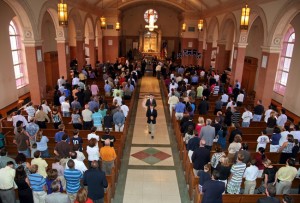As a pastoral planner and researcher for the Diocese of Cleveland, I spend a lot of time tracking ministry trends. One that has my attention at the moment is the degree to which parishes are becoming more intentional, organized and participative in their consultation and ministries.
This movement toward intentionality can be seen through a number of indicators, specifically the increasing use of mission statements, parish pastoral councils, and pastoral planning by parishes, as well as the broadening of consultation with the laity in the exercise of parish leadership.
Let me walk you through these trends using data from three national surveys of parish life I conducted with the National Pastoral Life Center in Manhattan: the first in 1990, the second in 1997 and the third in 2005. Since each study was largely a replication of the first, I’m able to present trend data over a 15 year period.1
Let’s begin with the use of mission statements, which are broad statements of the overall direction and purpose of the parish and are helpful in prioritizing pastoral activity and setting goals. In 1990, about one-third (29 percent) of parishes had mission statements; by 1997, it was about half (50 percent); and by 2005, it was more than three-quarters (78 percent). This suggests that parish leaders are being proactive in articulating specific ministry priorities for their parishes. While some may question the importance these statements play in guiding the day to day pastoral activity of their parishes, what is undeniable is that more parishes have them now than at any other time, and that that act of creating them is a sign of intentionality.
So is long-range planning. By 2005, three-fourths of parishes (74 percent) engaged in long-range planning, where only about half (53 percent) did in 1997. Parenthetically, about 34 percent of parishes engaged in pastoral planning in the late 1980s according to the Notre Dame Study of Catholic Parish Life.2 Therefore, the practice of pastoral planning has more than doubled during this time period. Long-range planning –the formulation of goals, objectives and action steps to advance the mission of the parish– is the quintessential indicator of intentionality in parish life.
This emphasis on planning can be directly linked to the shortage of priests and the merging, twinning, and clustering of parishes. As a follow-up to the planning question, the 2005 survey asked parishes whether their plans included sharing staff, resources, or programs with other Catholic parishes. Better than half (56 percent) said “yes.” Accompanying the growth in planning is a rise in the number of parish pastoral councils —often the primary agents in parish planning. Though we didn’t ask about parish councils in 1990, the Notre Dame Study of Catholic Parish Life (conducted a few years earlier) did and found that 76 percent of parishes had them.3 By 2005, the number had increased to 92 percent. Not only do more parishes have pastoral councils now than at any other time, some even have multiple forms of councils: one for their parish and one for their cluster. This is a relatively new practice that bears watching.
When asked the primary function of their pastoral councils, four-in-ten (42 percent) said “pastoral planning.” Another 33 percent said “consultation and feedback on parish pastoral activities.” Add the two together and we find that 75 percent of councils are involved in some form of planning, whether directly through leading the planning, or indirectly through providing consultation and feedback on staff initiatives. Clearly, Parish Pastoral Councils are the primary vehicle for the exercise of intentionality in parishes. Another vehicle of intentionality is consultation with parishioners at large when setting pastoral directions and priorities. We provided parishes with a list of ways parishioners could be consulted, and asked them to indicate how they are consulted in their parish. (SEE FIGURE 1)
FIGURE 1: METHOD MOST USED FOR CONSULTING PARISHIONERS
Method Percent
Consult PPC 77%
Parish Survey 52%
Town Hall Meeting 40%
Parish Leadership Assembly 36%
Program Evaluations 29%
Personal Interviews 22%
Website or Internet 17%
Focus Groups 10%
Other 7%
Clearly, consultation comes primarily through parish pastoral councils. Yet better than half of parishes (52 percent) conduct surveys, and four-in-ten (40 percent) hold town hall meetings. A third (36 percent) gather parish leaders to solicit input and a quarter conduct program evaluations. And the list continues. In most cases, parishes employ multiple methods of parishioner consultation. The data clearly shows that there is a great deal of collaboration and consultation taking place in parishes. In sum, intentionality in ministry has been growing steadily over time and manifests itself in the practice of planning and consultation. While many of the practices highlighted here are not new to parish life, they are nonetheless growing in prevalence. From a sociological perspective, a difference in degree –after a certain point—becomes a difference in kind. I would argue that we are becoming a different kind of church –a more intentional church– because of the prevalence of these practices. How have you seen this movement toward intentionality in your research or pastoral practice?
